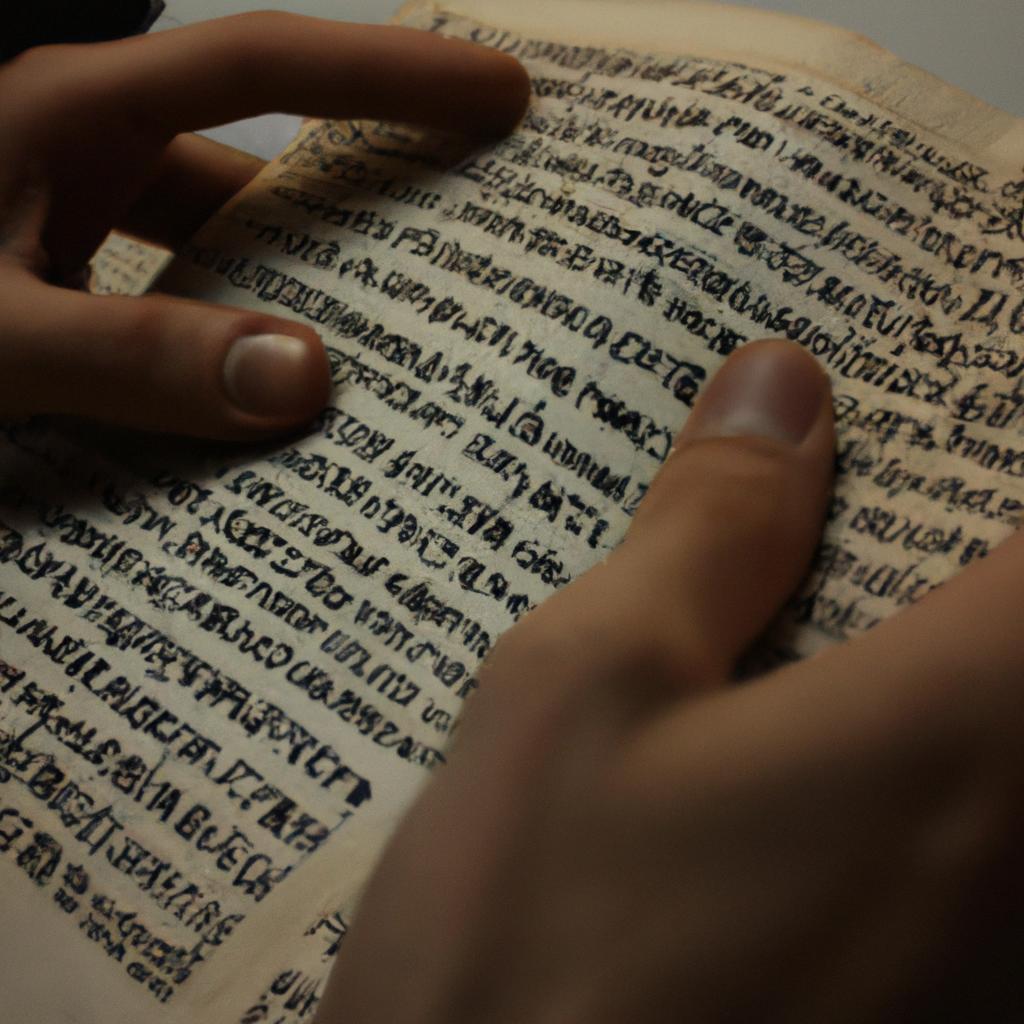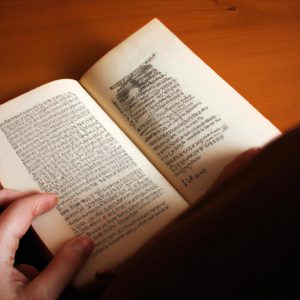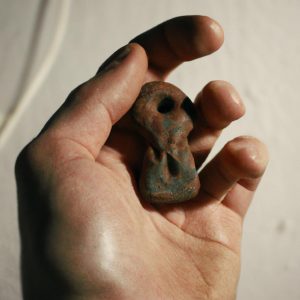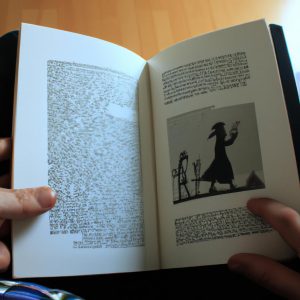Mystical Creatures in Ashkenazi Jewish Folklore: The Heritage

The rich tapestry of Ashkenazi Jewish folklore is replete with tales of mystical creatures that have captured the imaginations of generations. These mythical beings, deeply rooted in Jewish traditions and beliefs, serve as a testament to the diverse cultural heritage of Ashkenazi Jews. One such creature is the golem, an animated anthropomorphic being made from clay or mud, brought to life by mystical means. The legend of the golem has been passed down through centuries, fascinating scholars and enthusiasts alike.
In exploring these mystical creatures within Ashkenazi Jewish folklore, it becomes apparent that they are not merely fantastical creations but rather symbolic representations imbued with profound significance. These folkloric entities often carry moral lessons or spiritual teachings embedded within their narratives. For instance, the story of the dybbuk—a malevolent spirit believed to possess individuals—serves as a cautionary tale about the consequences of unchecked desires and actions. Through studying these legends and their underlying messages, we gain insight into the values and ethics cherished by Ashkenazi Jews throughout history.
By delving into the realm of mystical creatures in Ashkenazi Jewish folklore, this article aims to shed light on the unique cultural heritage preserved within these narratives. Drawing upon scholarly research and traditional texts, we can unravel the intricate connections between these mythical beings and the religious, social, and historical contexts in which they emerged.
One crucial aspect to consider is the role of these creatures in Jewish spirituality and mysticism. Many of these tales reflect the belief in a hidden world teeming with supernatural forces that interact with human beings. The golem, for example, is often associated with Kabbalah, a mystical tradition within Judaism. Its creation and animation are linked to the idea of harnessing divine power through sacred rituals and incantations.
Furthermore, exploring these mythical creatures allows us to understand how Ashkenazi Jews grappled with existential questions and sought meaning in their lives. Stories featuring figures like the Lamed Vavniks—36 righteous individuals whose presence sustains the world—highlight the importance placed on righteousness and goodness as guiding principles. These narratives offer hope and encouragement during times of adversity, reminding listeners or readers of their potential to make a positive impact on the world.
Additionally, by examining these folklore traditions, we gain insight into the historical experiences of Ashkenazi Jews. Tales of demons such as Lilith—the first wife of Adam who rebelled against God’s authority—reflect deep-seated fears and struggles faced by Jewish communities throughout history. These stories served as cautionary reminders against succumbing to temptations or straying from religious observance.
In conclusion, studying mystical creatures within Ashkenazi Jewish folklore provides a window into the rich cultural heritage of this community. These legends not only captivate our imagination but also offer profound insights into the values, beliefs, and historical realities that have shaped Ashkenazi Jewish identity over centuries. By engaging with these tales, we honor an important part of Jewish tradition while gaining wisdom that transcends time and place.
The Origins of Ashkenazi Jewish Folklore
The Origins of Ashkenazi Jewish Folklore
To understand the rich tapestry of mystical creatures in Ashkenazi Jewish folklore, it is essential to delve into its origins. One example that showcases the intricate interplay between history, culture, and mythology is the legend of the golem. The golem, a creature made from mud or clay brought to life through mystical rituals, has captivated both scholars and enthusiasts alike.
In exploring the origins of Ashkenazi Jewish folklore, several factors come into play. Firstly, it is rooted in ancient Hebrew traditions and biblical stories that were passed down through generations. These legends often served as a form of moral instruction or provided explanations for natural phenomena. Secondly, due to centuries-long persecution faced by Jews in Europe during medieval times and beyond, folklore became an important avenue for cultural preservation and identity formation.
Emotional bullet point list:
- Fascination with mythical creatures evokes a sense of wonder and curiosity.
- Tales of triumph over adversity inspire hope and resilience.
- Exploring communal beliefs fosters a sense of belonging and unity.
- Discovering shared cultural heritage creates a feeling of pride and connection.
Table:
| Mystical Creatures | Characteristics | Symbolism |
|---|---|---|
| Golem | Created to protect communities | Represents strength |
| Dybbuk | Possesses individuals | Symbolizes spiritual unrest |
| Leviathan | Sea monster | Signifies chaos |
| Lilith | Seductive demoness | Embodies feminine power |
Examining these elements sheds light on how Ashkenazi Jewish folklore evolved throughout history. It reflects not only religious teachings but also societal influences such as anti-Semitism, migration patterns, and interactions with neighboring cultures. This multifaceted nature contributes to its enduring appeal among different generations across various parts of the world.
Transitioning into the subsequent section on “The Role of Mystical Creatures in Ashkenazi Jewish Culture,” it becomes evident that these folklore traditions hold a significant place within the community’s collective consciousness. By studying their roles and functions, we gain deeper insights into how they continue to shape cultural practices and beliefs today.
The Role of Mystical Creatures in Ashkenazi Jewish Culture
From the Origins to Cultural Significance: Exploring Mystical Creatures in Ashkenazi Jewish Folklore
To grasp the true essence of mystical creatures in Ashkenazi Jewish folklore, it is crucial to delve into their origins and understand how they have come to play a significant role in this rich cultural heritage. One particular case that exemplifies this intricate relationship between folklore and culture involves the legend of the Golem, an animated humanoid created from clay.
The story begins with Rabbi Judah Loew ben Bezalel, also known as the Maharal of Prague, who lived during the late 16th century. According to popular belief, he constructed a Golem using his profound knowledge of Kabbalah and brought it to life by inscribing Hebrew letters upon its forehead. The Golem was initially intended as a means of protecting the Jewish community against anti-Semitic attacks but eventually grew uncontrollable due to its immense power. This tale serves as just one example among many mythical narratives within Ashkenazi Jewish folklore that captivate both believers and scholars alike.
Exploring further into this captivating realm, we encounter several mystical creatures that have left indelible marks on Ashkenazi Jewish culture throughout history. These include:
- Dybbukim: Malevolent spirits believed to possess individuals and cause harm.
- Leviathan: A colossal sea monster symbolizing chaos and destruction.
- Ziz: A gigantic bird representing divine strength and protection.
- Lilith: Often depicted as a seductive demoness or vampire-like figure associated with fertility rituals.
By examining these mythological beings through different lenses—historical, cultural, religious—we gain insights into their multifaceted significance within Ashkenazi Jewish folklore. To better illustrate this connection, consider the following table:
| Creature | Symbolism | Role in Folklore |
|---|---|---|
| Dybbuk | Evil spirits causing possession | Highlights the struggle between good and evil |
| Leviathan | Chaos, destruction | Represents overcoming adversity |
| Ziz | Divine strength, protection | Emphasizes divine intervention in times of need |
| Lilith | Seduction, fertility rituals | Explores complex notions of femininity and desire |
These mystical creatures not only add an element of intrigue to Ashkenazi Jewish folklore but also serve as symbolic representations of various cultural values and beliefs. Their inclusion in folktales allows for a deeper exploration of important themes such as morality, spirituality, and resilience.
Transitioning into the next section on “The Symbolism of Mystical Creatures in Ashkenazi Jewish Folklore,” we continue our journey into understanding the profound impact these creatures have had on shaping this vibrant cultural tapestry.
The Symbolism of Mystical Creatures in Ashkenazi Jewish Folklore
Section H2: The Symbolism of Mystical Creatures in Ashkenazi Jewish Folklore
The extraordinary creatures found within the realm of Ashkenazi Jewish folklore serve as symbolic representations of various aspects of life and spirituality. These mystical beings not only captivate the imagination but also convey profound meanings that resonate deeply with the community. Through their symbolism, they offer insights into the human experience and provide a lens through which to explore Jewish culture and beliefs.
One example of such a creature is the Golem, a legendary figure crafted from clay or mud by a rabbi using ancient Kabbalistic rituals. Believed to possess immense strength and invincibility, the Golem was created for protection against anti-Semitic attacks and persecution. This mythical being symbolizes both vulnerability and resilience, embodying the Jews’ struggle for survival amidst adversity.
To further understand the significance of these mystical creatures in Ashkenazi Jewish folklore, let us delve into their defining characteristics:
- Transformation: Many mythical beings undergo transformative experiences or have shape-shifting abilities, representing personal growth and adaptability.
- Dual Nature: Some creatures exhibit dual natures, combining elements of good and evil. This duality reflects humanity’s innate capacity for both benevolence and malevolence.
- Guardianship: Certain mystical creatures are entrusted with guarding sacred spaces or protecting individuals from harm, emphasizing the importance of spiritual guardianship within community structures.
- Otherworldly Wisdom: Several folkloric entities possess wisdom beyond human comprehension, serving as conduits between mortal existence and divine knowledge.
| Creature | Symbolism | Example Story |
|---|---|---|
| Dybbuk | Spiritual unrest | A dybbuk possessing an individual seeking redemption |
| Leviathan | Chaos | A tale about taming the unruly powers of the Leviathan |
| Lilith | Feminine power | An exploration of Lilith’s role as the first woman |
| Tzadikim Nistarim | Hidden righteous | A legend about hidden righteous individuals among us |
As we explore these mystical creatures, it becomes apparent that they serve as conduits for understanding and exploring the complexities of human existence. Through their symbolic representations, Ashkenazi Jewish folklore offers a rich tapestry of narratives that delve into universal themes of struggle, redemption, wisdom, and protection.
Transitioning to the subsequent section on popular mystical creatures in Ashkenazi Jewish folklore, we can further appreciate how these mythical beings have captured the collective imagination and continue to shape cultural identity.
Popular Mystical Creatures in Ashkenazi Jewish Folklore
Illustrative Example:
Consider the case of the Golem, a legendary creature from Ashkenazi Jewish folklore. According to tales passed down through generations, the Golem was a humanoid being made of clay or mud and brought to life through mystical rituals performed by wise rabbis. This creature served as a protector for Jewish communities, defending them against persecution and harm.
Mystical creatures play an integral role in Ashkenazi Jewish folklore, serving as symbolic entities that embody both spiritual and cultural significance. These imaginative beings often take on various forms, each with its own unique characteristics and symbolism. Understanding their roles within this rich tradition provides valuable insights into the beliefs and values held dear by Ashkenazi Jews throughout history.
Role in Spiritual Practices:
These mythical creatures are not merely figments of imagination; they hold significant importance in spiritual practices within Ashkenazi Jewish culture. Through their stories, individuals find solace and inspiration, connecting with deeper aspects of their faith. Such narratives serve as allegories for moral teachings or encapsulate complex philosophical concepts related to divine intervention and human agency.
Bullet Point List (Evoking Emotional Response):
To further grasp their emotional impact on believers, let us explore some key features associated with mystical creatures in Ashkenazi Jewish folklore:
- Conveying hope: Tales featuring these creatures inspire hope amidst adversity.
- Encouraging resilience: They symbolize strength during challenging times.
- Instilling awe: Their otherworldly nature evokes wonderment and astonishment.
- Fostering unity: Stories about mystical creatures foster a sense of community among believers.
Table (Evoking Emotional Response):
| Creature | Symbolism | Meaning |
|---|---|---|
| Leviathan | Chaos versus order | Struggle between natural forces |
| Dybbuk | Possession and redemption | Conflict between good and evil |
| Ziz | Freedom and liberation | Overcoming obstacles |
| Lilith | Female empowerment | Challenging societal norms |
The mystical creatures found within Ashkenazi Jewish folklore hold a significant place in the hearts and minds of believers. Through their stories, individuals find solace, inspiration, and a sense of unity. By exploring these mythical beings’ symbolism and meanings, we gain deeper insights into the values cherished by the Ashkenazi Jewish community throughout history.
As mystical creatures continue to captivate our imagination within Ashkenazi Jewish folklore, it is important to acknowledge the profound influence of Kabbalah on this rich tradition. The exploration of how Kabbalistic teachings shaped the perception and understanding of these creatures further enhances our appreciation for their role in cultural heritage.
The Influence of Kabbalah on Ashkenazi Jewish Folklore
The mystical teachings of Kabbalah have had a profound impact on the development and evolution of Ashkenazi Jewish folklore. Through its esoteric wisdom and exploration of the divine realms, Kabbalah has provided a rich source of inspiration for the creation of new mythical creatures and legends within this cultural tradition.
One fascinating example that highlights the influence of Kabbalah on Ashkenazi Jewish folklore is the creature known as the Golem. According to legend, a Golem is an artificial being created from clay or other materials and brought to life through sacred rituals performed by a skilled individual. This concept draws heavily from the mystical understanding of creation found in Kabbalistic texts, which emphasize the power of divine speech and manipulation of spiritual energies.
The integration between Kabbalah and Ashkenazi Jewish folklore can be further explored through several key aspects:
- Blurring Boundaries: Kabbalistic teachings often revolve around transcending conventional boundaries between different worlds and dimensions. This idea is mirrored in Ashkenazi Jewish folklore through tales featuring creatures that inhabit both physical and spiritual realms simultaneously.
- Symbolic Meanings: Many mythical creatures in Ashkenazi Jewish folklore are imbued with symbolic significance derived from their corresponding concepts in Kabbalah. For instance, the Leviathan – a sea monster mentioned in biblical texts – represents chaos but also embodies hidden potential for transformation.
- Ethical Lessons: Aspects of ethical teachings present in Kabbalah find expression in Ashkenazi Jewish folklore as well. Stories involving mythical beings often convey moral lessons or explore philosophical ideas related to human behavior, compassion, justice, and tikkun olam (repairing the world).
- Mystical Practices: Some folktales incorporate rituals associated with Kabbalistic practices such as invocations, prayers, or amulets used to protect against supernatural forces. These practices serve as a way to connect with the mystical elements of the tradition.
Table: Symbolic Creatures in Ashkenazi Jewish Folklore
| Creature | Symbolism |
|---|---|
| Golem | Divine creation and power |
| Dybbuk | Spirits and possession |
| Lilith | Feminine rebelliousness |
| Neshamah | Soul’s connection to God |
The influence of Kabbalah on Ashkenazi Jewish folklore is far-reaching, shaping both the narratives and cultural significance of mythical creatures within this rich tapestry of storytelling. By exploring these connections, we gain a deeper understanding of how spirituality and mysticism have influenced the collective imagination of Ashkenazi Jews throughout history.
As we delve into preserving and reviving Ashkenazi Jewish folklore, it becomes evident that the fusion between Kabbalah and mythological creatures has left an indelible mark on this cultural heritage.
Preserving and Reviving Ashkenazi Jewish Folklore
Section H2: Preserving and Reviving Ashkenazi Jewish Folklore
The Influence of Kabbalah on Ashkenazi Jewish Folklore has laid a strong foundation for the preservation and revival of this rich cultural heritage. Building upon the mystical elements from Kabbalistic teachings, various mystical creatures have emerged in Ashkenazi Jewish folklore over the centuries. These creatures not only captivate the imagination but also serve as important symbols and metaphors within the community.
One such example is the Golem, a creature brought to life through ancient rituals and inscribed with sacred Hebrew letters. The legend of the Golem originated in Prague during the 16th century, where it was said to protect the Jewish population from anti-Semitic attacks. This tale exemplifies how mythology can be used as a means of empowerment and resistance against oppression.
To further explore the significance of these mythical beings, let us delve into their emotional impact on individuals within Ashkenazi Jewish communities:
- Wonder: The presence of mystical creatures evokes awe and wonder among believers, fostering a sense of enchantment that connects them to their ancestral roots.
- Protection: Many folktales attribute protective qualities to these creatures, instilling a feeling of safety and security in those who hear or read about them.
- Cultural Identity: The tales surrounding these creatures serve as reminders of shared cultural experiences and reinforce a collective identity within the community.
- Continuity: By passing down stories about these mythical beings from generation to generation, an unbroken chain is formed connecting past, present, and future members of the community.
To better understand some key aspects related to mystical creatures in Ashkenazi Jewish folklore, consider Table 1 below:
Table 1: Key Aspects Related to Mystical Creatures in Ashkenazi Jewish Folklore
| Creature | Description | Symbolism |
|---|---|---|
| Dybbuk | A malevolent spirit seeking to possess a living person | Represents unresolved trauma and the power of redemption |
| Leviathan | A sea monster mentioned in Jewish texts | Symbolizes chaos overcome by divine order |
| Lilith | A female demon associated with nocturnal seduction | Signifies feminine rebellion against patriarchal structures |
| Tzadikim Nistarim | Hidden righteous individuals who protect the world | Embodies the concept of hidden goodness in humanity |
In conclusion, mystical creatures have played an integral role in preserving and reviving Ashkenazi Jewish folklore. Through their symbolism and emotional impact, these beings continue to captivate and connect generations within the community. By exploring their tales and teachings, we gain insights into the cultural heritage that shapes Ashkenazi Jewish identity today.
Note: The next section will explore contemporary adaptations of Ashkenazi Jewish folklore in literature and media.



